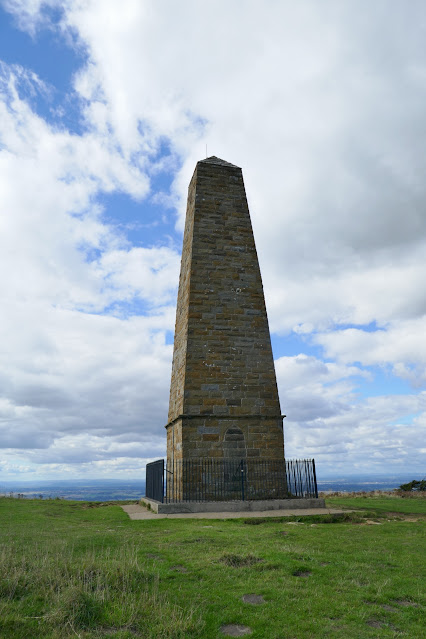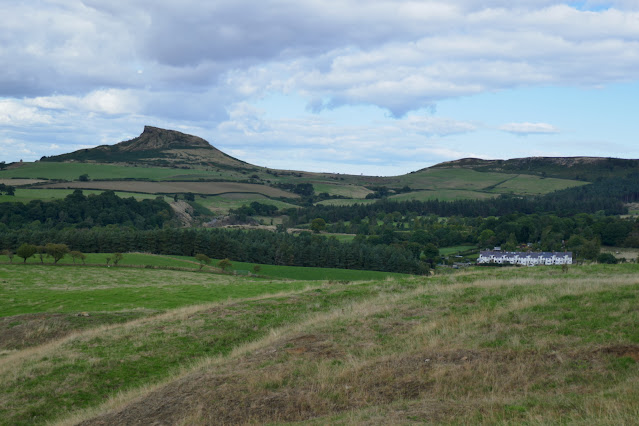Captain Cook Country from Great Ayton
8 miles Fine and dry
We parked on Great Ayton High Street near to Suggitt's Cafe and crossed the River Leven by the steel bridge opposite the cafe. We paused briefly to admire the old pissoir which has been located near the bridge as a non-operational feature and painted red for some reason. There were originally three of these and to my recollection they were painted a tasteful green and I remember being glad of their presence when I was a child and used to cycle to Ayton from Middlesbrough.
 |
| Today's route from The Walker's Guide to the Cleveland Hills |
 |
| New feature on bridge commemorating... |
 |
| ... fallen soldiers from WWI |
 |
| Crossing the Leven on the said bridge |
 |
| Victorian loo - gentlemen only please |
 |
| The sluice gate still in situ |
Leaving the old urinal we read a nearby notice board which told us about the flood of 1840, that caused much damage and destroyed the Fulling Mill at Kildale. We would visit the site of the old mill later during today's walk.
Leaving Waterfall Park behind we followed field paths along the River Leven soon reaching Woodhouse Farm.
 |
| "This is your last warning - we're coming through!" Horses near Woodhouse Farm |
 |
| Tricky field paths |
 |
| Woodhouse Farm |
 |
| "Built 1712,Rebuilt 1905, Mod. 1962" |
After crossing Woodhouse Farm's horse paddock and a bridge over the river to Easby Lane, we walked through Easby and over the railway bridge.
 |
| "See you later young cowboy", Flowers beneath this indicate a 'pop-up' shrine in the hedge |
 |
| Easby Bridge |
 |
| Easby Village |
 |
| Jockey in garden of Easby Mill |
 |
| Hunter weather vane at Easby Mill |
 |
| Leaving Easby village |
After walking through the village we stayed on the tarmac road for half a mile before crossing a way-marked stile into fields just before Borough Green Farm where we began a steady climb to Easby Moor.
As we climbed we saw two hikers walking down towards us and on meeting discovered one was Stephen, a reader of this blog who hails from the York area and has walked all of TSB's routes. They had travelled up to Kildale this morning to walk a circular hike covering part of the Cleveland Way. It was very nice to bump into them and discuss our common interest in walking in North Yorks, hello Stephen, if you're reading this!
Leaving the ruins of the mill we followed the river along the concessionary path. On a bend in the track we saw a stone memorial inscribed 'Black Pepper'. TSB tells us this this marks the burial place of the favourite pony of Cecily Turton from Kildale Hall. Poor Cecily died in the 'flu epidemic of 1919 aged 20. We decided the horse must have dropped dead at this spot, as it would have been very difficult to bring it here for burial.
 |
| Black Pepper memorial stone |
 |
| Kildale Force waterfall would have been a nice spot for coffee |
 |
| ... but now fenced off and out of bounds! |
Eventually we came out of the woods below Bankside Farm where large stones positioned to deter motorists from parking made ideal seats for our coffee stop.
 |
| Coffee and scones at Bankside |
 |
| Bankside Farm |
 |
| Climbing above Bankside Farm Kildale Church comes into view |
 |
| Robin at Bankside Farm |
We followed the farm road uphill from Bankside Farm and were delighted to spot a slow worm basking in the sun at the side of the road. Apparently the slow worm is actually a legless lizard and not a snake as is commonly believed and our slow worm was a juvenile, shown by its dark underside and shortish length. (approx 9")
 |
| Also called a bind worm, its tiny eyes do function |
 |
| "and away..." |
Leaving the slow worm in the sun we came to a fork where we turned left to walk through the trees of Coate Moor. A gentle climb led us to Captain Cook's Monument.
A steep climb followed, up the tarmac track to Aireyholme Farm where there is a fine view over to Roseberry.
Aireyholme Farm is famous for being the workplace of Captain Cook's father, who was bailiff there in 1736.
 |
| Duck Pond at Aireyholme Farm |
 |
| Aireyholme Farm |
Our path now took us through two farm gates to Aireyholme Cottage where we turned sharp left. This track took us below Cliff Rigg Quarry, where whinstone was mined. This hard reddish stone is the remains of a volcanic explosion on the west coast of Scotland about 58 million years ago, and is the only such stone on the Yorkshire moors.
Descending from the quarry we crossed the railway line once more before following the path towards Cleveland Lodge.
 |
| Magnificent Undercliffe Hall over to our left |
Back in Great Ayton we walked along the High Street and took the opportunity to collect pies from Petch's Pie Shop before changing out of our boots and popping into the Royal Oak for a pint to end our day's walk in the pub's beer garden.
 |
| "To legless lizards everywhere!" |























































